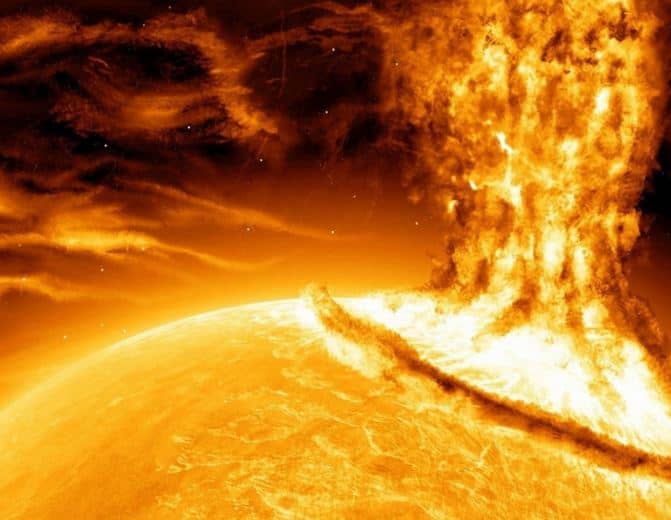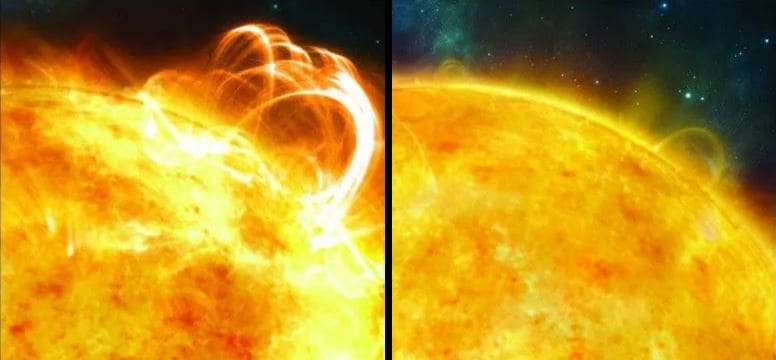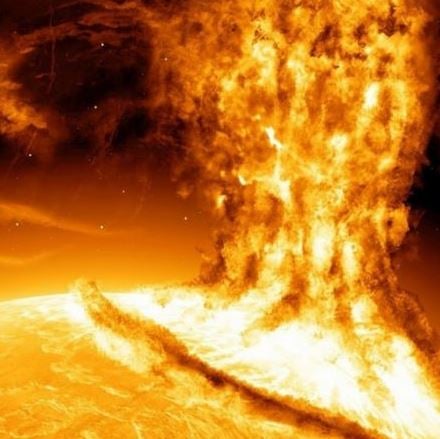A solar superflare could knock out our global electricity supply and send us back to pre-industrial times, with households using candles for lighting and washing clothes by hand, say researchers from the University of Warwick in the United Kingdom who analyzed a superflare from a star with similar physics to those of our Sun.
Our current hi-tech civilization depends on electricity for just about everything. Without it, most of the things we do and rely on would grind to a halt.
Study leader, Chloë Pugh, a PhD student, and colleagues studied a stellar superflare. Stellar refers to stars, while solar refers to our Sun. A stellar superflare is one produced by a star, while a solar superflare would be one produced by the Sun.
 An artist’s depiction of a superflare. In 2015, NASA’s Swift satellite spotted a stellar superflare on a nearby star so powerful that, had it been from our sun, it would have triggered a mass extinction on Earth.
An artist’s depiction of a superflare. In 2015, NASA’s Swift satellite spotted a stellar superflare on a nearby star so powerful that, had it been from our sun, it would have triggered a mass extinction on Earth.
What are superflares?
Stellar superflares are colossal magnetic eruptions in the atmosphere of stars – mega explosions that can occur on solar-like stars, which are thousands of times more powerful than normal solar flares.
Scientists at the University of Warwick’s Centre for Fusion, Space and Astrophysics wrote about their observations and conclusions regarding a superflare in The Astrophysical Journal Letters, which the American Astronomical Society chose as its publisher.
NASA’s Kepler space telescope, a space observatory launched in 2009 to discover Earth-like planets outside our solar system, detected a stellar superflare that had wave patterns similar to those found in the Sun’s flares, the scientists explained.
The superflare was spotted in, a binary star – a star system consisting of two stars – called KIC9655129. KIC9655129, which is in the Milky Way, is known to sometimes produce superflares. The authors wrote that its superflares are similar to solar ones, so they both probably share the same underling physics of flares.
The Sun is able to produce superflares
Given everything we know about our Sun, there is no reason why it should not have the capacity to produce mega-powerful superflares too.
An average solar flare is already pretty powerful – with the energy-equivalent of about 100 million megaton bombs. But that is nothing compared to a solar superflare, which would have the energy-equivalent of at least 100 billion megaton bombs. Such power coming out of the surface of the Sun and heading towards Earth would be devastating.
The explosion from a superflare would not only produce a surge of visible light, but also a huge cloud of charged particles and detached magnetic loops – a ‘CME’ (coronal mass ejection) – that would be hurled directly towards Earth. According to NASA Science, when the CME arrived, it would crash into our planet’s magnetic field, causing a global bubble of magnetism that surrounds Earth to shake and quiver – there would be a magnetic storm.
 An artist’s depiction of the Sun producing a superflare (left) and a ‘quiet’ Sun. (Image: University of Warwick)
An artist’s depiction of the Sun producing a superflare (left) and a ‘quiet’ Sun. (Image: University of Warwick)
Our electric cables would instantly start producing sparks and would then catch fire, possibly across the whole planet. GPS and communication systems and the electricity grid would be knocked out. For modern, tech-dependent civilization today, the consequences would be catastrophic.
Ms. Pugh explained:
“Our solar system is filled with plasma, or ionised gas, originating from the Sun as a result of the solar wind and other more violent solar eruptions, such as solar flares. Stars very similar to the Sun have been observed to produce enormous flares, called superflares.”
“To give us a better indication of whether the Sun could produce a catastrophic superflare, we need to determine whether the same physical processes are responsible for both stellar superflares and solar flares.”
“Solar flares are commonly observed to consist of a series of regularly occurring pulses. Often these pulsations resemble waves, with a wavelength that relates to various properties of the region of the Sun that is producing the flare. The study of waves such as these is referred to as coronal seismology.”
“Occasionally solar flares contain multiple waves superimposed on top of one another, which can easily be explained by coronal seismology. We have found evidence for multiple waves, or multiple periodicities, in a stellar superflare, and the properties of these waves are consistent with those that occur in solar flares.”
 Ms. Pugh wrote: “Many stars not dissimilar from the Sun have been observed to produce flares several orders of magnitude greater than any solar flare on record. Due to the potential for substantial damage in the near-Earth environment associated with powerful flares, it is important to work towards determining whether a superflare could ever occur on the Sun.” (Image: University of Warwick)
Ms. Pugh wrote: “Many stars not dissimilar from the Sun have been observed to produce flares several orders of magnitude greater than any solar flare on record. Due to the potential for substantial damage in the near-Earth environment associated with powerful flares, it is important to work towards determining whether a superflare could ever occur on the Sun.” (Image: University of Warwick)
Several systems we rely on would shut down
Power blackouts across the planet would mean that all of our computer systems would grind to a halt. Traffic controllers would no longer be able to guide airplanes in and out of airports or through busy traffic routes, flying aircraft would not be able to navigate and perhaps even their flight systems would fail, our cities would have no functioning traffic lights, we would not be able to fill our cars with fuel because the pumps would be out of service.
Our hospitals would be in trouble because medical devices and laboratory equipment, as well as elevators and other machines need electricity to function. Back-up generators could only help for basic services. How would doctors, nurses and other hospital personnel get to work on time with no functioning traffic lights, etc?
Millions of factories would not be able to operate. Hundreds of millions of people worldwide would have to be laid off until we restored our electricity supply.
Ms. Pugh added:
“Fortunately the conditions needed for a superflare are extremely unlikely to occur on the Sun, based on previous observations of solar activity.”
In this study, the scientists used time series analysis to examine wave patterns in the light curve of a superflare from KIC9655129, using data gathered by the Kepler space telescope.
Co-author Dr. Anne-Marie Broomhall, whose research fouses on stellar and solar physics, specifically asteroseismology and helioseismology (the study of the propagation of wave oscillations), said:
“When a flare occurs we typically see a rapid increase in intensity followed by a gradual decline. Usually the decline phase is relatively smooth but occasionally there are noticeable bumps, which are termed ‘quasi-periodic pulsations’ or QPPs. We used techniques called wavelet analysis and Monte Carlo modelling in order to assess the periodicity and statistical significance of these QPPs.”
Their analysis revealed two significant periodicities, with a less than one percent probability that they would be observed by chance.
Dr. Broomhall added:
“We then fitted a model to the flare light curve that described both the exponential decay phase and the two periodicities. The periods were found to be 78 minutes and 32 minutes respectively. The properties of the periodicities, such as their decay times, imply that the two periodicities are independent.”
“The most plausible explanation for the presence of two independent periodicities is that the QPPs were caused by magnetohydrodynamic (MHD) oscillations, which are frequently observed in solar flares. This result is, therefore, an indication that the same physical processes are involved in both solar flares and stellar superflares. The latter finding supports the hypothesis that the Sun is able to produce a potentially devastating superflare.”
 Another Carrington Event today would start with spectacular sights in the sky, followed by a period of darkness and great suffering for humankind.
Another Carrington Event today would start with spectacular sights in the sky, followed by a period of darkness and great suffering for humankind.
The Carrington Event 1859 – a major solar storm
A large solar flare caused the largest solar storm on record in 1859. It is known as the Carrington Event, named after British astronomer Richard Carrington (1826-1875) who witnessed the massive solar flare. He was the first person to identify a link between the Sun’s activity and geomagnetic changes on Earth.
During the Carrington Event, the Northern Lights (aurora borealis) could be observed as far south as Cuba and Honolulu, while the Southern Lights (aurora australis) were visible as far north as Santiago, the capital of Chile.
Telegraph wires and equipment produces sparks, people said, and in many causes there were fires.
The Carrington Event caused some problems in 1859. But in those days there were no computers, cars, airplanes, electric lighting in homes, telephones, Internet, and other hi-tech things we rely so much on now.
 The flares were so powerful that people could read newspaper print in the northeastern US just from the light of the aurora. (Image: phys.hawaii.edu)
The flares were so powerful that people could read newspaper print in the northeastern US just from the light of the aurora. (Image: phys.hawaii.edu)
Such an event today would push us back centuries, and it would take several weeks, months and perhaps years to get things working properly again.
Daniel Baker, who works at the University of Colorado’s Laboratory for Atmospheric and Space Physics, was quoted by National Geographic as saying:
“Imagine large cities without power for a week, a month, or a year. The losses could be $1 to $2 trillion, and the effects could be felt for years.”
The research was funded by a European Research Council project that co-author Professor Valery M. Nakariakov led.
Citation: A. -M. Broomhall, C. E. Pugh and V. M. Nakariakov. “A Multi-Period Oscillation in a Stellar Superflare.” The Astrophysical Journal Letters. DOI: 10.1088/2041-8205/813/1/L5.
Video – Footage of strong solar flare
In January 2014, NASA’s Interface Region Imaging Spectrograph witnessed an M-class flare, the strongest it had seen since it was launched. A superflare would be thousands of times more powerful than this one.

